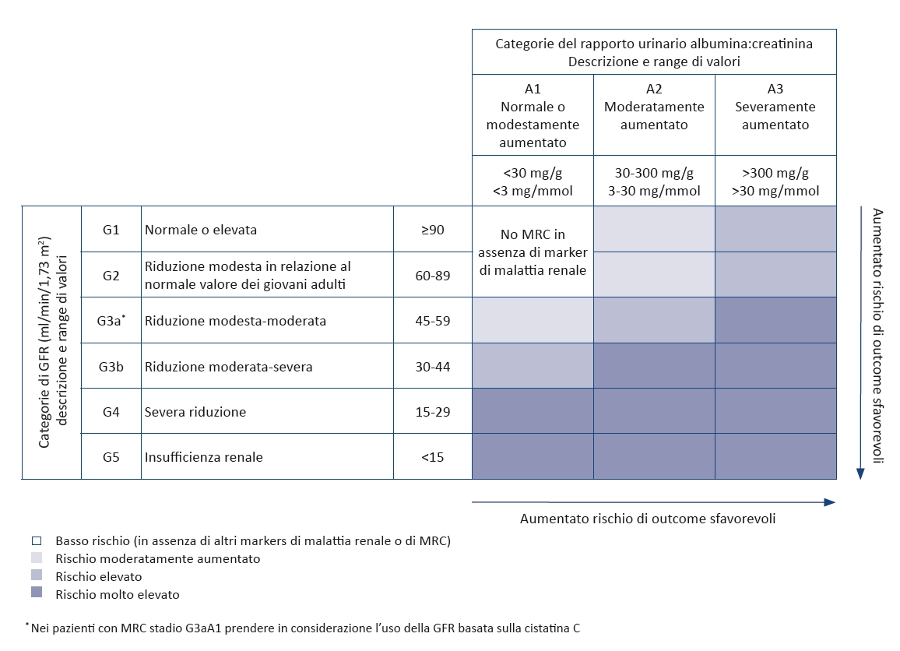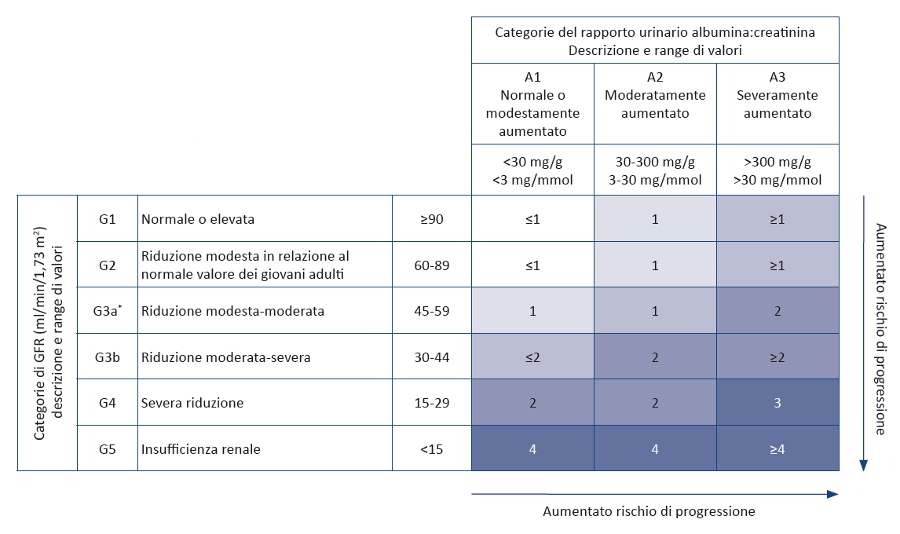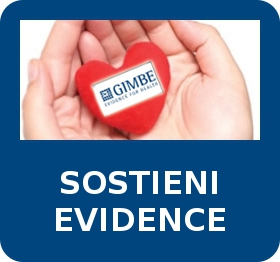Best practice
Evidence 2014;6(10): e1000090 doi: 10.4470/E1000090
Pubblicato: 16 ottobre 2014
Copyright: © 2014 Cartabellotta. Questo è un articolo open-access, distribuito con licenza Creative Commons Attribution, che ne consente l’utilizzo, la distribuzione e la riproduzione su qualsiasi supporto esclusivamente per fini non commerciali, a condizione di riportare sempre autore e citazione originale.
Dopo la pubblicazione nel 2012 di una definizione e una classificazione della malattia renale cronica (MRC) condivise a livello internazionale, sono proliferate pubblicazioni relative a vari aspetti della MRC: diagnosi, fattori di rischio di progressione, rilevanti fattori prognostici (1). Inoltre, è ancora vivo il dibattito sui criteri utilizzati per la definizione della MRC e sulle precise modalità con cui l’invecchiamento influenza la MRC e le sue sequele (2,3).
Il National Institute for Health and Care Excellence (NICE) ha aggiornato le raccomandazioni precedenti sulla classificazione della MRC (4), basandosi sia sul Kidney Disease Improving Global Outcomes (KDIGO) (5), sia sui dati prognostici provenienti da studi osservazionali di grandi dimensioni. Il NICE ha inoltre avvertito la necessità di una migliore identificazione dei pazienti a rischio di outcome sfavorevoli e di trattare alcuni argomenti fondamentali correlati al trattamento della MRC, inclusa la frequenza di monitoraggio, la progressione, l’insufficienza renale acuta e il sistema di blocco del sistema renina-angiotensina.
Questo articolo sintetizza le piĂą recenti raccomandazioni del NICE (6), basate su una revisione sistematica delle migliori evidenze disponibili e sull’esplicita considerazione della costo-efficacia degli interventi sanitari. Quando le evidenze sono limitate, le raccomandazioni si basano sull’esperienza del gruppo che ha prodotto la linea guida — Guidelines Development Group (GDG) — e sulle norme di buona pratica clinica. I livelli di evidenza delle raccomandazioni cliniche sono indicati in corsivo tra parentesi quadre.
1. Indagini diagnostiche
- I laboratori di analisi dovrebbero:
- utilizzare l’equazione Chronic Kidney Disease Epidemiology Collaboration (CKD-EPI) per stimare la velocitĂ di filtrazione glomerulare — glomerular filtration rate (GFR) — della creatinina, usando misure calibrate secondo standard internazionali
- utilizzare test di creatinina specifici (es. quelli enzimatici) possibilmente con scarti minimi tendenziali verso lo zero, piuttosto che la spettrometria di massa con isotopi
- partecipare a programmi di valutazione della qualitĂ per la calibratura della creatinina
- Considerare per la diagnosi iniziale la stima della GFR basata sulla cistatina C (box) per confermare o escludere MRC in soggetti con:
- GFR tra 45 e 59 ml/min/1,73 mq da almeno 90 giorni, e
- assenza di proteinuria o di altri marker di malattia renale (box)
|
Box. Definizioni
|
- Non porre diagnosi di MRC nei soggetti con:
- GFR basata sulla creatinina tra 45-59 mL/min/1.73 mq, e
- GFR basata sulla cistatina C >60 mL/min/1.73 mq, e
- nessun altro marker di malattia renale
- Per evidenziare e identificare la proteinuria, utilizzare preferibilmente il rapporto urinario albumina:creatinina, piuttosto che quello proteine:creatinina, per la sua maggiore sensibilità a bassi livelli di proteinuria. Per la quantificazione e il monitoraggio di livelli elevati di proteinuria (rapporto albumina:creatinina >70 mg/mmol), il rapporto proteine:creatinina può essere un’alternativa. Nei pazienti diabetici è raccomandato il rapporto urinario albumina:creatinina. [Raccomandazione basata sull’esperienza e l’opinione del GDG]
- Prescrivere test per l’identificazione della MRC usando la stima della GFR basta sulla creatinina e il rapporto urinario albumina:creatinina nei pazienti con uno o più dei seguenti fattori di rischio:
- diabete
- ipertensione
- insufficienza renale acuta
- malattia cardiovascolare (cardiopatia ischemica, scompenso cardiaco cronico, vasculopatia periferica, malattia cerebrovascolare)
- malattie delle vie urinarie: litiasi renale, ipertrofia prostatica
- malattie sistemiche con potenziale interessamento renale (es. lupus eritematoso sistemico)
- storia familiare di insufficienza renale terminale o malattia renale ereditaria
- rilevazione casuale di ematuria
- riduzione della GFR associata a un aumentato rischio di outcome sfavorevole
- aumento del rapporto albumina:creatinina associato a una riduzione della GFR che moltiplica il rischio di outcome sfavorevoli
2. Classificazione della malattia renale cronica
- Classificare la MRC utilizzando la combinazione tra le categorie di GFR e quelle del rapporto urinario albumina:creatinina (figura 1).
- Essere consapevoli che l’aumento del rapporto urinario albumina:creatinina si associa a un aumento del rischio di outcome sfavorevoli.
- Un reperto occasionale di proteinuria clinicamente rilevante dovrebbe sempre essere considerato nel contesto della categoria di GFR.

3. Indicazioni per l’ecografia renale
- Prescrivere un’ecografia renale a tutti i pazienti con MRC e:
- progressione accelerata della MRC
- ematuria persistente, visibile o invisibile
- sintomi di ostruzione urinaria
- storia familiare di rene policistico nei pazienti di etĂ >20 anni
- GFR <30 mL/min/1.73 mq (categoria GFR G4 o G5)
- indicazione alla biopsia renale, secondo valutazione del nefrologo
- stima della GFR e del rapporto urinario albumina:creatinina effettuata con modelli meno recenti, tenendo conto che la progressione della MRC spesso non è lineare
- comorbiditĂ , in particolare scompenso cardiaco
- modifiche della terapia (antagonisti del sistema renina-angiotensina-aldosterone, farmaci antinfiammatori non steroidei, diuretici)
- malattie intercorrenti
- preferenza per la terapia conservativa della MRC
4. Frequenza di monitoraggio
- Utilizzare la figura 2 per stabilire la frequenza di monitoraggio nei pazienti con MRC o a rischio di MRC, personalizzandola sulle caratteristiche del soggetto e tenendo conto della causa sottostante di MRC.
- Monitorare lo sviluppo o la progressione della MRC per almeno 2-3 anni dopo un episodio di insufficienza renale acuta, anche se i livelli ematici di creatinina sono rientrati nella norma.
[Raccomandazioni basate su studi retrospettivi di coorte di qualitĂ moderata]

5. Progressione della malattia renale cronica
- La progressione accelerata di MRC viene definita come:
- consistente riduzione della GFR ≥25% e un cambiamento di categoria di GFR nell’arco dei 12 mesi, oppure
- consistente riduzione della GFR di 15 ml/min/1,73 mq per anno
6. Self-management
- Garantire tutte le condizione volte a:
- informare della loro diagnosi i pazienti con MRC
- condividere con i pazienti le decisioni terapeutiche
- incoraggiare il self-management fornendo informazioni su livelli di pressione arteriosa, disassuefazione al fumo, esercizio fisico, dieta e farmaci
- rendere i pazienti in grado di prendere decisioni consapevoli e informate
Tutti i pazienti con MRC dovrebbero essere incoraggiati a: praticare attività fisica, condurre una vita sana, astenersi dal fumo, ridurre l’assunzione di sale a meno di 6/g al giorno.
7. Criteri per l’invio allo specialista
- Dovrebbero essere inviati a una valutazione specialistica i pazienti con MRC e:
- GFR <30 mL/min/1.73 mq (categoria GFR G4 o G5), affetti o meno da diabete (a)
- rapporto urinario albumina:creatinina ≥70 mg/mmol, non conseguente al diabete giĂ adeguatamente trattato
- rapporto urinario albumina:creatinina ≥30 mg/mmol (categoria A3) in presenza di ematuria
- consistente riduzione della GFR ≥25% e cambiamento di categoria di GFR, o consistente diminuzione della GFR ≥15 mL/min/1.73 mq nell’arco dei 12 mesi
- scarso controllo dell’ipertensione nonostante l’uso di almeno quattro farmaci antipertensivi a dosi terapeutiche
- malattia rara o genetica, sospetta o nota, che può causare MRC
- sospetta stenosi dell’arteria renale
- I soggetti con MRC e ostruzione delle vie urinarie dovrebbero di norma essere inviati ai servizi specialistici di urologia, a meno che non sia necessario un intervento medico urgente (es. terapia dell’iperpotassiemia, uremia severa, acidosi, sovraccarico idrico).
[Raccomandazioni basate sull’esperienza e l’opinione del GDG]
(a) In caso di un reperto isolato e stabile, una consulenza specialistica potrebbe non essere indicata ed essere sufficiente solo un consiglio. L’obiettivo è di evitare un tardivo invio allo specialista dei soggetti in cui la progressione della malattia può necessitare un trattamento sostitutivo della funzione renale entro un anno
8. Terapia farmacologica
8.1. Scelta degli antipertensivi e controllo pressorio (b)
- Prescrivere un antagonista del sistema renina-angiotensina a basso costo ai pazienti con MRC e:
- diabete e rapporto urinario di albumina:creatinina ≥3 mg/mmol (categoria A2 o A3)
- ipertensione e rapporto urinario albumina: creatinina ≥30 mg/mmol (categoria A3)
- rapporto albumina:creatinina ≥70 mg/mmol (categoria A2 o A3) indipendentemente da ipertensione o malattia cardiovascolare
- Nei pazienti con MRC non prescrivere una combinazione di antagonisti del sistema renina-angiotensina. [Raccomandazione basata su evidenze da trial controllati randomizzati di qualitĂ da moderata a molto bassa]
- Nei pazienti non diabetici con MRC, ipertensione e un rapporto urinario albumina:creatinina <30 mg/mmol (categoria A1 e A2) seguire le raccomandazioni della linea guida sull’ipertensione (9). [Raccomandazione basata su evidenze da trialcontrollati randomizzati di qualità da elevata a molto bassa e su evidenze di costo-efficacia]
- Nei pazienti con MRC l’obiettivo è mantenere la pressione sistolica <140mmHg (valori desiderati 120-139 mmHg) e la pressione diastolica <90 mmHg (c).
- Nei pazienti con MRC e diabete e in quelli con rapporto urinario albumina:creatinina ≥70 mg/mmol (categoria A3), l’obiettivo è mantenere la pressione arteriosa <130 mmHg (valori desiderati 120-129 mmHg) e quella diastolica <80 mmHg (c).
(b) Le evidenze che supportano questi criteri riguardano esclusivamente i pazienti di etĂ >70 anni.
(c) Le raccomandazioni per il controllo dell’ipertensione nei pazienti con MRC, diabete e rapporto urinario di albumina:creatinina =3 mg/mmol (categoria A2 e A3) non sono state aggiornate.
8.2. Antiaggreganti
- Prescrivere antiaggreganti a pazienti con MRC per la prevenzione secondaria della malattia cardiovascolare, tenendo sempre in considerazione l’aumentato rischio di sanguinamento. [Raccomandazione basata su studi osservazionali e sull’esperienza e l’opinione del GDG]
9. Potenziali ostacoli all’implementazione
Le soglie per la diagnosi di MRC e la definizione della sua progressione rimangono controverse. Nella popolazione adulta, l’equazione basata sulla creatinina CKD-EPI riduce l’errore della stima della GFR e ha una maggiore precisione, permettendo di assegnare alle giuste categorie i pazienti a rischio più elevato di morte per qualunque causa, di mortalità cardiovascolare, di infarto miocardico, di progressione della MRC e di insufficienza renale terminale (10,11).
La classificazione tramite la GFR è attualmente integrata dalla categorizzazione del rapporto albumina:creatinina. Forti evidenze dimostrano che sia una ridotta GFR sia un elevato rapporto urinario albumina:creatinina sono correlati in maniera indipendente alla mortalità , a eventi cardiovascolari, alla progressione verso l’insufficienza renale cronica terminale e anche all’insufficienza renale acuta. Nonostante l’assenza di trial clinici condotti su pazienti con differenti categorie di rapporto urinario albumina:creatinina, l’albuminuria aumenta il rischio di insufficienza renale acuta e questa è predittiva della progressione di MRC. Le diagnosi di MRC in soggetti senza una proteinuria significativa nella categoria G3–A1, specialmente nelle persone anziane, sono in costante aumento, suscitando preoccupazioni rispetto al fenomeno dell’overdiagnosis. Grazie alla cistatina C è possibile identificare i pazienti a rischio più elevato di outcome sfavorevoli, inclusa l’insufficienza renale cronica terminale, riducendo le preoccupazioni sulla potenziale overdiagnosis e sulla classificazione della malattia.
Altra questione controversa è la definizione di progressione della MRC. La raccomandazione è supportata dai risultati di studi recenti e riconosce sia la variabilità della creatinina serica nella valutazione della GFR, sia il fatto che la progressione della malattia renale spesso non è lineare (12-14). è stato adottato il termine “progressione accelerata” nella consapevolezza che il declino segnalato nella GFR tra pazienti con MRC può essere più basso (5). Infine, la classificazione sulla base della GFR e del rapporto urinario albumina:creatinina fornisce un quadro di riferimento per la frequenza di monitoraggio dei pazienti con MRC accertata, supportando l’eventuale decisione di invio allo specialista.
10. Quali raccomandazioni per la ricerca futura?
Il GDG ha identificato alcune aree prioritarie per la ricerca:
- Gli interventi educazionali e di supporto offerti dai professionisti sanitari aumentano nei pazienti le competenze, la sicurezza e la fiducia nel gestire la propria condizione e migliorano gli esiti clinici?
- Nei pazienti con MRC a rischio molto elevato di malattia cardiovascolare, qual è l’efficacia di basse dosi di aspirina, rispetto al placebo, per la prevenzione primaria della malattia cardiovascolare?
- Nei soggetti con MRC di età >75 anni, qual è l’efficacia dei bloccanti del sistema renina-angiotensina-aldosterone?
- Nei pazienti con MRC a maggior rischio di progressione, qual è l’efficacia e la costo-efficacia dei farmaci ipouricemizzanti sulla progressione della MRC e sulla mortalità ?
- Nei pazienti con iperparatiroidismo secondario dovuto alla MRC, il trattamento con vitamina D, o suoi analoghi, migliora gli esiti clinici?
Contributo degli Autori
-Disclosure dei conflitti di interesse
Nessuno dichiaratoIndirizzo per la corrispondenza
nino.cartabellotta@gimbe.orgProvenienza
Non commissionato, non sottoposto a peer-reviewFonti di finanziamento
NessunaApprovazione comitato etico
-Pagina aggiornata il 16/ottobre/2014



